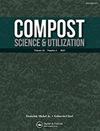小规模堆肥过程中实验室培育的拟舟花Calonectria pseudonaculata Microsclerotia的存活
IF 0.9
4区 农林科学
Q3 ECOLOGY
引用次数: 4
摘要
黄杨疫病(Calonectria pseudonaviculata)是黄杨属(Buxus spp.)的一种破坏性真菌病,于2011年在美国首次发现。由于所产生的微菌核的持久性,人们担心堆肥可能成为病媒。以往的研究表明,假曲霉在中温环境下是非常稳定的,但在堆肥过程中没有对假曲霉进行评价。我们的目的是评估在40、50和60°C的温度下堆肥24、48和72小时后假小木犀草的存活率。堆肥使用新创建的生物反应器系统进行,允许精确控制堆肥过程。结合堆肥评价,在孵化器中评价了相同的温度/时间组合。虽然病原菌在40°C培养箱中存活72 h,但堆肥存活率极低,在相同温度下24 h仅观察到一些存活率。我们能够确定在≥50°C的温度下暴露24小时或更长时间,并且在40°C的堆肥系统中暴露48小时或更长时间会杀死微菌核。本文章由计算机程序翻译,如有差异,请以英文原文为准。
Survival of Lab Grown Calonectria pseudonaviculata Microsclerotia During Small-Scale Composting
Abstract Boxwood blight, caused by Calonectria pseudonaviculata, is a devastating fungal disease of Buxus spp., first observed in the United States in 2011. Due to the persistent nature of the produced microsclerotia, concern arose over the potential for compost to serve as a disease vector. Previous work demonstrated that C. pseudonaviculata is very stable at mesophilic temperatures, however, no previous work has evaluated C. pseudonaviculata during composting. Our objective was to evaluate the survival of C. pseudonaviculata microsclerotia after being composted for 24, 48, and 72 h at temperatures of 40, 50, and 60 °C. Composting was performed using a newly created bioreactor system, allowing for precise control of the composting process. In conjunction with the composting evaluations, the same temperature/time combinations were evaluated in incubators. While the pathogen survived 40 °C through 72 h in an incubator, compost survival was minimal, with only some survival observed at 24 h at the same temperature. We were able to determine that exposure to temperatures ≥50 °C for 24 h or longer, and that exposure in a composting system for 48 h or longer at 40 °C would kill the microsclerotia.
求助全文
通过发布文献求助,成功后即可免费获取论文全文。
去求助
来源期刊

Compost Science & Utilization
农林科学-生态学
CiteScore
4.10
自引率
0.00%
发文量
0
审稿时长
>36 weeks
期刊介绍:
4 issues per year
Compost Science & Utilization is currently abstracted/indexed in: CABI Agriculture & Environment Abstracts, CSA Biotechnology and Environmental Engineering Abstracts, EBSCOhost Abstracts, Elsevier Compendex and GEOBASE Abstracts, PubMed, ProQuest Science Abstracts, and Thomson Reuters Biological Abstracts and Science Citation Index
 求助内容:
求助内容: 应助结果提醒方式:
应助结果提醒方式:


